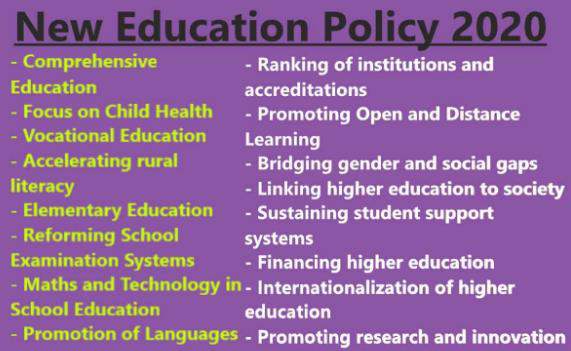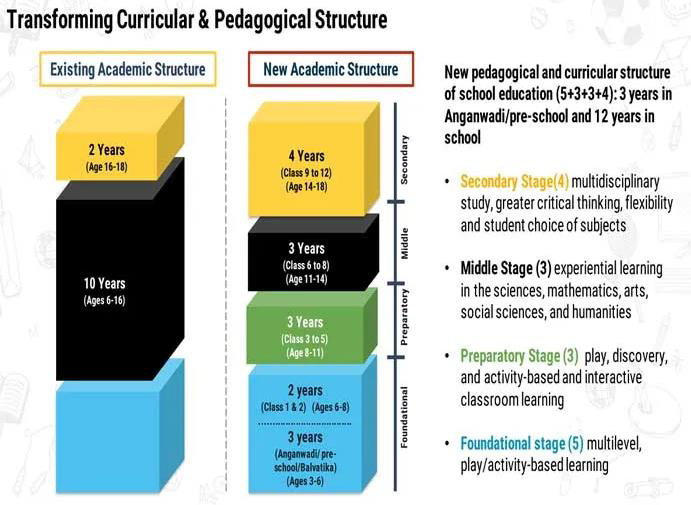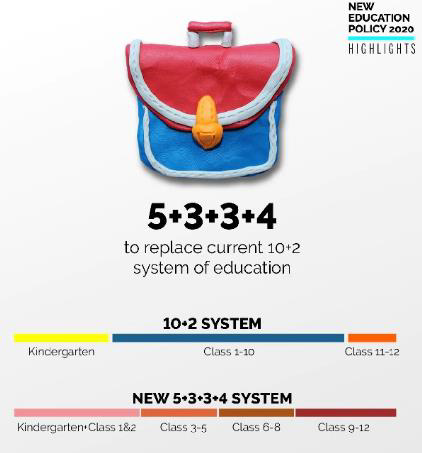
NEP 2020 , One of the main announcements of the new national education policy will break the prevailing 10 + 2 structure and introduce the 5 + 3 + 3 + 4 frameworks of faculty education. The policy aims to rework the circular and academic structure from the present 10 years + 2 years into a more comprehensive foundation for the second phase change.
However, there’ll be no change within the actual system, while a toddler will spend at the varsity level within the formal education system of the country, while the new structure will close the prevailing playschools within the scope of ‘formal education’. The new structure and comparison of the 2 is described below.
NEP 2020:
10 + 2 5 + 3 + 3 + 4 Teaching Structure Explained (Explained) To begin with, the particular number of years is that the same and doesn’t mean an additional year. It can probably be found a live school, nursery or kindergarten classes with grades 1 and a couple of.
See here the proposed new educational framework compared to the present one. Today, a student (in most urban cities) enters formal education at the age of three through playschools.
Then he goes to a ‘school’, which is that the K12 Institute – Kindergarten 1st and 2nd and 12th years secondary then higher education. The new structure now proposes to divide an equivalent structure into stages of children’s cognitive development – childhood, school years and secondary stages.
-
Foundation Stage (5):
For 3 to 8 year olds, the foundation step is indicated. Kindergarten classes in Multi-Level Play Activity Based Learning range from 3 years old to Anganwadi, pre-school or general playschool and 3 to 6 years old. For this, for classes 1 and 2 or for students of classes 1 and 2. 6 to 8 year olds will also be included, focusing on language-based skills and teaching through sports-based and activity-based curricula.
-
Preliminary Stage (3):
This is Stage 11 or Class 3 to 5. The focus shifts to game, innovation and activity-oriented and interactive classroom learning. This stage will focus on the development of language and numerical skills according to the cognitive development of the child. The medium of instruction up to 5th class is home language or mother tongue or local language. All students are taught three languages – and which states decide.
-
Middle stage (3):
Referring from 4th grade to Ferring, the new structure aims to change the teaching from the current system for more experienced learning in science, mathematics, arts, social sciences, and humanities. The focus will be on key learning goals rather than on root learning.
-
Secondary (4):
This includes grades 9 to 12 or secondary and upper secondary classes. The changes suggested at this level involve a multi-disciplinary study where students can choose any subject from the available structure. In addition to technology and art, the focus is on more complex thinking and flexibility, allowing the child to choose topics that suit his or her interests.
Highlight
- NEP 2020 will have 3 to 8 elementary phases, 8 to 11 three-year pre-primary education, 11 to 14 elementary phases, and 14 to 18 years of secondary phases.
- School students take exams only for grades 3, 5, and 8. In other years the assessment will change to a “regular and formal” style, which will be more “merit-based”
- Board exams continue for grades 10 and 12 but are redesigned with “total”
- Integrating vocational education and internships from the sixth grade onwards will also be a high priority. Its goal is to equip students with new skills.
- Carpentry, electrical work, metalwork, gardening, pottery making, etc. should start during grades 6-8, as determined by states and local associations.
- This is to ensure that at least 50 percent of students by 2025 are widely exposed to vocational education. Therefore, classes 6 to 8 will be given a ten-day bagless period in which students will have the opportunity to do an internship with a local professional.
- Coding will begin for 6th graders.
- The evaluation system is comprehensive and uses artificial intelligence to show learning results, errors, and any corrective actions to each student. Promotion
- So far there has been a clear distinction between ‘policy’, ‘additional’, or ‘co-curricular’ activities, with the new approach, all intended to be integrated. In addition to science, humanities, and mathematics, topics such as physical education, arts and crafts and vocational skills will be included in current school curricula.
What are the criteria for assessing students?
NEP 2020 is poised to move from a concise assessment to a general and grammatical assessment that is more efficient-oriented, promotes learning and development, and tests high-level skills such as analysis, critical thinking, and conceptual clarity. Does. All students take the school exams in grades 3, 5, and 8, which are administered by the appropriate authority. Board exams will continue for grades 10 and 12, but overall development has been targeted. The new National Assessment Center, PARAKH (Performance Assessment, Review, and Analysis of Knowledge for Overall Development), will be established as the standard-setting organization.
How Do Undergraduate and Postgraduate Streams Work?
UG education lasts for 3 or 4 years, during which time there are many exit options and appropriate certification. For example, a graduate with a certificate after one year, an advanced diploma after 2 years, a bachelor’s degree after 3 years, and research after 4 years. The Academic Bank of Credit should be set up to store the earned academic credits digitally and be calculated up to the final degree. Multi-disciplinary education and research universities with IITs, and IIMs will be set up across the country.




